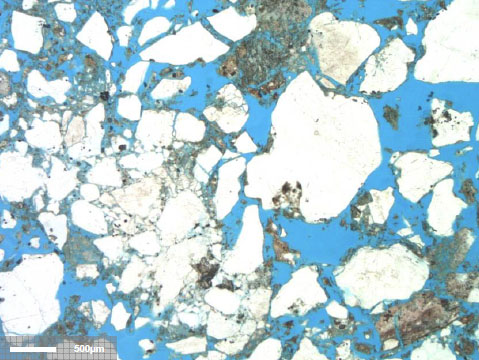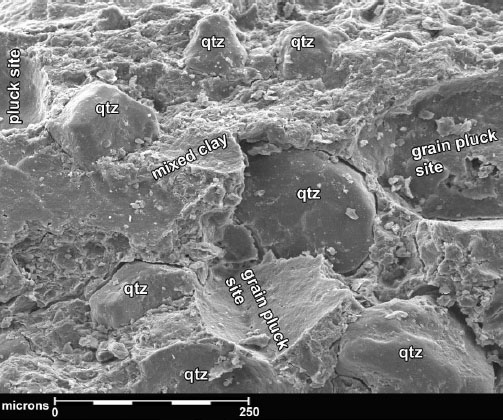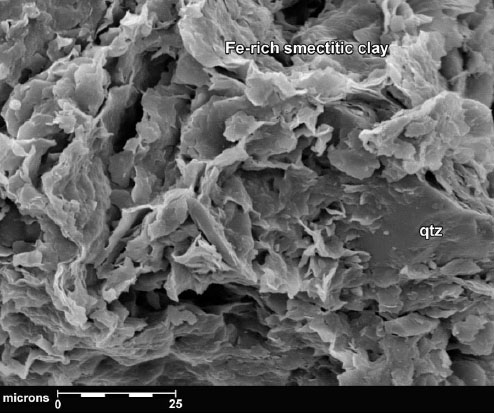
|
 Downloads
Downloads
|
 Prices
Prices
|
 Videos
Videos
|
GeolOil - Vshale or Vclay? How to compute them from well logs
By: Oscar Gonzalez, GeolOil LLC. This paper was first published on September 2020 on the website geoloil.com
Vshale (and not Vclay), is what is normally estimated in well logging. In a stratigraphic column —particularly in clastic environmets— it is common to find pure shales (100% VSH sediments). Those shales are tight rocks (say sealing, with permeabilities in the range of nano-Darcies), that are built mostly of clays, and minor proportions of tiny hydrogen free silt size particles (up to around 0.06 millimeters of "rock dust"), with quartz (SiO2) and some lithic minerals like feldspars and plagioclases.
A typical pure gray shale rock, usually contains 65% of clays or more (like illite, smectite, chlorite, and kaolinite). Shalines or clayness indicators derived from gamma ray, and hydrogen neutron-density porosity, respond mostly to the presence of clays, not to the presence of silt particles —clays trap traces of GR emitting minerals, and clays have hydrogen in their chemical formulae—
That maximum indicator response detected on a pure shale, does not mean that the shale is built 100% only with clays (even mudstones and claystones are not 100% clay). The maximum signal of the indicator is related to a maximum of 100% shale sediment that has blends of clays and silt, seldom a maximum of 100% of clay.
Unless a rock body with almost 100% of clay content is found to tie to a log indicator, there is not normally an easy way to estimate directly Vclay, nor to differentiate what is silt and what are rock grains. They have the same non-clay minerals: they only differ in their size. To estimate Vclay, a companion independent piece of information is needed. On way is to access lab data:
- Take a pure shale rock and bring it to a lab. Make sure it is indeed a pure shale, i.e. only clays and silts, without rock grains, sands or shaly sands.
- Analyze the sample and measure the proportions of all minerals. X Ray Diffraction (XRD) is one of the preferred techniques for this, but you may also try with electric microscopic imaging techniques, or perhaps thin sections.
- Sum all the clay mineral proportions and all the non-clay (silt) mineral proportions.
- Define pSilt as the ratio between the non-clay (silt) minerals to the rock total (clays + silt). The correct proportions to take should be volume proportions instead of weight proportions. However, they usually produce somewhat similar numbers for practical log practices.
- Then, assuming that the shale sediments (the clay sediments + silt sediments blend) nature and its proportions in the pure shale rock (VSH=100%) are approximately similar to the ones in shaly rocks (VSH < 100%), we can estimate Vclay (VCL) by:
- Notice that only if pSilt=0, VCL=VSH, which seldom occurs. If the clays and silts nature, distributions, and proportions are significantly heterogeneous throughout the reservoir, then pSilt is no longer a constant, but the former approach can still be applied by modeling pSilt as a space variable, that is, pSilt = pSilt (x,y,z) should be estimated and interpolated in the reservoir.

Many shale rocks have pClay > 0.65. —like the top one from the photograph below— That is, pSilt = SILTprop < 0.35. GeolOil defaults pSilt=0.25 and pClay=0.75 for many of its internal equations and mineral solvers. You are welcome to replace this default value with a custom lab measured one, or even use a pSilt(z) LAS curve on its own right instead of a constant.

A sealing clastic shale at the top blocking black oil migration
The following table shows an example of an XRD lab result proportions of the gray shale from a shallow, clastic fluvial environment, shown in the top zone of the above photograph, on regular light.
| Mineral | Proportion |
| Quartz | 0.16 |
| Feldspar | 0.01 |
| Smectite | 0.35 |
| Illite | 0.07 |
| Kaolinite | 0.27 |
| Chlorite | 0.14 |
| Total | 1.00 |
For the table above, pSilt=0.16+0.01=0.17 (17%), and pClay = 0.83 (83%)
The top zone is a classic pure shale, so VSH=1.0, and VCL = pClay * 1 = 0.83. In spite that pSilt=0.17 >0, the silt size particles of quartz and feldspar are so tiny that still conforms a perfect seal that stopped oil upward flow migration (and also has a fully impregnated irreducible water saturation that traps the formation water, so SWt=1.0 and SWirr=1.0 in the shale).
The bottom zone of the photograph, is a shaly sandstone (0 < VSH < 1, far to be a clean sand), in which the oil resides (the black stain in regular light indicates oil). By gravitational segregation, the oil tries to flow upwards (because oil is less dense than water), but the shale above blocked the migration, conforming a reservoir trap.
This shaly sand needs a VSH adjustment to properly estimate its water saturation.
 Low magnification
Low magnification

Thin Section of a core at a low magnification
A TS Thin-Section photograph from an optical microscope, of a moderately clean sand from a braided channel system. Its VSH is around 20% approximately for the whole rock. The blue filling is the rock pore space. The white grains are quartz SiO2.
 Medium magnification
Medium magnification

A SEM Scan-Electronic-Microscope photograph of a shaly sandstone
The image to the left shows a SEM Scan-Electronic-Microscope photograph of a tight, very shaly sandstone
from a braided channel system.
Notice the big difference in size between the individually visible quartz SiO2 sand grains,
and the detrital clay blend, so small that it looks at the shown magnification, as a plastic dough.
However, as seen in the next photograph below, such "clay doughs" have porosity.
 High magnification
High magnification

A SEM Scan-Electronic-Microscope photograph of a shaly sandstone at a high magnification
A SEM Scan-Electronic-Microscope photograph of a clastic, sealing gray shale.
The high magnification of the photograph, allows to see the smectite clay scales.
Towards the lower right corner of the photograph, a detrital quartz SiO2 particle is seen.
Such particle has a size larger than a clay, but smaller than a grain sand: It is a silt size
particle. Since this shale has some silt and minor lithic silt size particles, Vshale=100%
but Vclay <100%, because Vsilt > 0%.
The tiny total micro-porosity seen, fully traps unmovable water.
So φT >0, but φe = 0.
Unless the shale becomes fractured, for practical reservoir exploitation purposes,
the rock conforms a seal, with absolute permeability in the order of nano-Darcies.
 GeolOil is listed by the official
SPWLA software directory
GeolOil is listed by the official
SPWLA software directory
| |



|
|
|
© 2012-2025 GeolOil LLC. Please link or refer us under Creative Commons License CC-by-ND |




 TRAINING
TRAINING

 PAPERS
PAPERS
 REFERENCES
REFERENCES
 GET IN TOUCH
GET IN TOUCH


